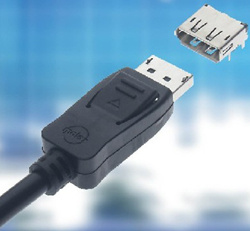 DisplayPort is a digital display interfaced standard. The Video Electronic Standards Association (VESA) is promoting the standard, which is a license-free, digital audio/video interconnect. It is designed primarily to connect between computer equipment and a display monitor or home theater system. Rival standards to DisplayPort are VGA, Digital Video Interface (DVI) and High-definition Multimedia Interface (HDMI) (video signal is not compatible with either standard).
DisplayPort is a digital display interfaced standard. The Video Electronic Standards Association (VESA) is promoting the standard, which is a license-free, digital audio/video interconnect. It is designed primarily to connect between computer equipment and a display monitor or home theater system. Rival standards to DisplayPort are VGA, Digital Video Interface (DVI) and High-definition Multimedia Interface (HDMI) (video signal is not compatible with either standard).
DisplayPort offers particularly low power consumption and a low pin count. It supports 10.8 Gigabits/second data transfer and WQXGA (2560×1600) resolution over a 15-meter cable, making it a particularly attractive rival to HDMI.

Content Protection
To be a serious rival with today's high definition video content in mind, you have to offer some form of content protection. DisplayPort offers two forms of content protection, both that use cryptographic methods to protect content as it travels between devices.
DPCP- stands for DisplayPort Content Protection, which is licensed separately from the DisplayPort standard. It was developed by Phillips and uses 128-bit AES encryption, with modern cryptography ciphers. It includes an independent key revocation system.
HDCP - stands for High-bandwidth Digital Content Protection. DisplayPort Revision 1.1 added support for this content protection standard developed by Intel subsidiary Digital Content Protection, LLC. HDCP is also used with some DVI connectors and with HDMI.
News History
- DisplayPort gets huge boost with HDCP (3 January 2007)
